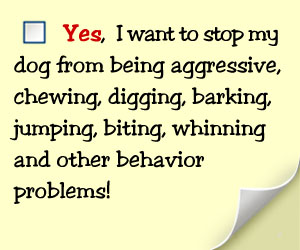A common pet among many people are dogs. Dogs make great household companions, as they are very lovable and playful. Dogs can be a great pet for anyone if they are trained properly. Use the advice in the following article if you need help training your dog.
Taking a dog on a daily walk, or even two, is an essential part of obedience training. a dog without exercise is not a calm dog, and it's very hard to train a dog in an excited state. It is best to take them out before any rigorous training exercise so that they are tired and in a submissive state when you begin to teach them.
Give your dog a clear verbal cue that means "yes" to aid in training. Certain words like "yes" are great for bridging the time between obeying an order and receiving the reward.
If your dog barks and growls at strangers in your home, do this: leash your dog, make him sit, wait until his attention is on you, and hand the leash, in full view of the dog, to your guest. Then wait until the dog is calm again, with the guest giving commands as needed. This teaches the dog that your guest ranks above him in "the pack" and he must accept them. When the dog starts to react again, repeat the exercise.
If your dog is not listening while you are doing dog training, make sure that the dog is not ill. There will be no benefits to punishing your animal if it is not feeling well, and it can have very detrimental effects afterwards. If you are unable to decide if the dog is sick then contact a veterinarian for assistance.
Always be sure to have a reward or tasty morsel for your dog when he follows a command or learns something new. You want to teach your pooch that good behavior is beneficial. This is a great way to make certain the dog grasps what is right and what is wrong.
When getting a new dog it is important to create a bond between the owner and the dog. One of the best ways to build this bond is by taking the dog on long walks at least two or three times a week. This activity creates a link between owner and pet and will also provide valuable training time.
Don't give a puppy too much information and training at once, or you'll wear him out. Puppies do not have a very long attention span and limited energy, keep it brief and positive. A training session that wears your puppy out is going to turn into an unpleasant memory, making him less likely to respond well to subsequent sessions, and more inclined to ignore what you are trying to teach him.
When you are walking your dog, be aware of and pay attention to other dogs in the vicinity. There are irresponsible dog owners and dogs who feel they need to be in charge to make up for this. This is a bad combination. If you see a dog that seems to be unsociable or defensive, you must avoid it.
A great dog training tip is to let your dog know when they're doing something right. It's very easy to yell at your dog and tell them no when they're misbehaving. It's important to let your dog know when they're doing what you want because that reinforces good behavior
One trick to remember when training your pet is that the things that you do will surely mold its behavior throughout its life. This is especially important when it comes to playtime. Do your best to lead your dog in a positive direction.
A good tip is to get a breed of dog that matches your lifestyle. If you have kids, you'll want a breed that's good with kids. Chihuahuas have become really popular over the years and many families have started buying them. They aren't great with kids however, and a lot of them are being left in shelters.
When you travel with a dog, you need to anticipate all of its needs to help it avoid unwanted behaviors or accidents. Don't forget essentials like food and water, and bathroom items. Do not fret about food for your dog, you can buy it wherever you are.
Walking should be a time for you to work on your relationship with your dog. Your dog shouldn't totally ignore you in lieu of squirrels, trees and other interesting things. Instead, keep him occupied with commands and rewards for great work. This will encourage heeling and attentiveness in your dog.
In conclusion, dogs are a common pet for people. Dogs are playful, lovable, and make great companions. When properly trained, dogs are good pets for anyone. If you remember the advice from this article, then your dog will be properly trained and a lovable companion for you.











